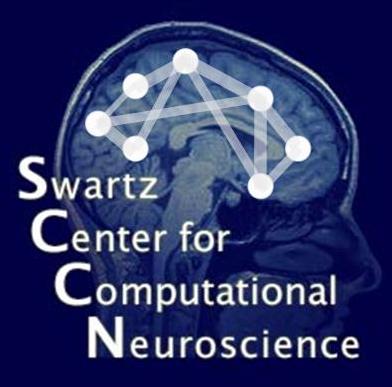
SCCN Home
EEGLAB Home
FMRLAB v4.0
Release Note
Dear FMRALB Colleagues,
I am very glad to announce that we are releasing the newest version of FMRLAB, version 4.0. In this newest release,
we added some nice features into the toolbox:
- More ICA decomposition options: For example, users can choose from binary runica()
routine compiled for Linux and Mac OSX as executables for faster and more reliable ICA decomposition
or skewed ICA decomposition to account for mostly positive-value distribution of functional MR images.
- Accounting for global mean in spatial domain (taking out mean image) before ICA decomposition:
Since the implemented ICA decomposition codes account
for the mean time course of the input fMRI data automatically but leave the (image) mean in spatial domain
in the decomposition process. This may affect ICA decomposition results. By subtracting the mean image from decomposed data,
the decomposition result may be less biased by the mean image. Users can choose to decompose their data with
or without removing the mean image in the graphic user interface.
- Function to suggest potential component(s) of interest: In this version, we implemented a
function to suggest potentially “good” components by measure the compactness and connectedness
of components' activation maps (ROAs). This function tried to mimic component selection by human experts,
who may screen through all components and pick the ones with compact active brain regions.
- More options to order resultant independent components. We provided component power, component kurtosis,
component skewness, component variance, and ROA map complexity in this newly released version.
- A new, nice graphic user interface for exporting ROA maps of selected components. Users need not
memorize if they need to turn on "flip" or "resort" options to make right orientation of their exported component maps.
A nice interactive GUI visualizing 3D orientation of the ROA maps with clear target orientation displayed as reference
will guide users to export their ROA maps in correct orientation to interface with other software for further processes or visualization.
- A nice, user-transparent spatial normalization process based on flirt routine as implemented in FSL was incorporated to
spatially normalize ROA maps of independent components to MNI brain template. Author would like to thank Prof. Steve Smith
and Dr. Mark Jenkinson for their kind permission, allowing us to put the flirt function into FMRALB for spatially normalizing
activation maps (ROAs) to standard MNI brain template.
- A model selection function based on Bayesian (and Akaike) information criterion was implemented (not recommended to use, though).
We feel very sorry to postpone this release for such a long period of time. In order to provide better features,
we have intensively tested, for example, the reliability of ICA decomposition with huge amount of fMRI data
and also developed group analysis procedures in FMRLAB recently. We promise to keep this software toolbox up
to date with all newly developed nice features. We are now testing new functions to select components based on
some prior knowledge input by users. We will publish these functions soon after we fully test them.
Finally, the newly released version of FMRLAB can be freely downloaded at
https://sccn.ucsd.edu/fmrlab.
As always, we will greatly appreciate any suggestions and comments to make FMRLAB run better. In the same
time, if any bugs found with this toolbox, please feel free to report them by emailing me at
duann@sccn.ucsd.edu or fmrlab_user@sccn.ucsd.edu.
Thank you for your time and wish you all the best.
Sincerely,
JR
Jeng-Ren Duann, PhD
Institute for Neural Computation,
University of California San Diego
9500 Gilman Dr. Mail Code: 0961
La Jolla, CA 92093
TEL: 858-458-1927
FAX: 858-458-1847
E-mail: duann@sccn.ucsd.edu
